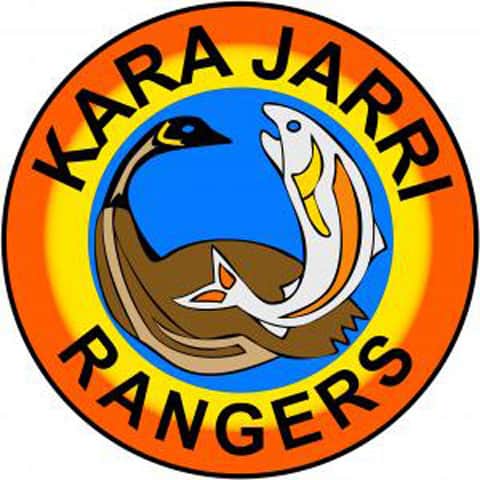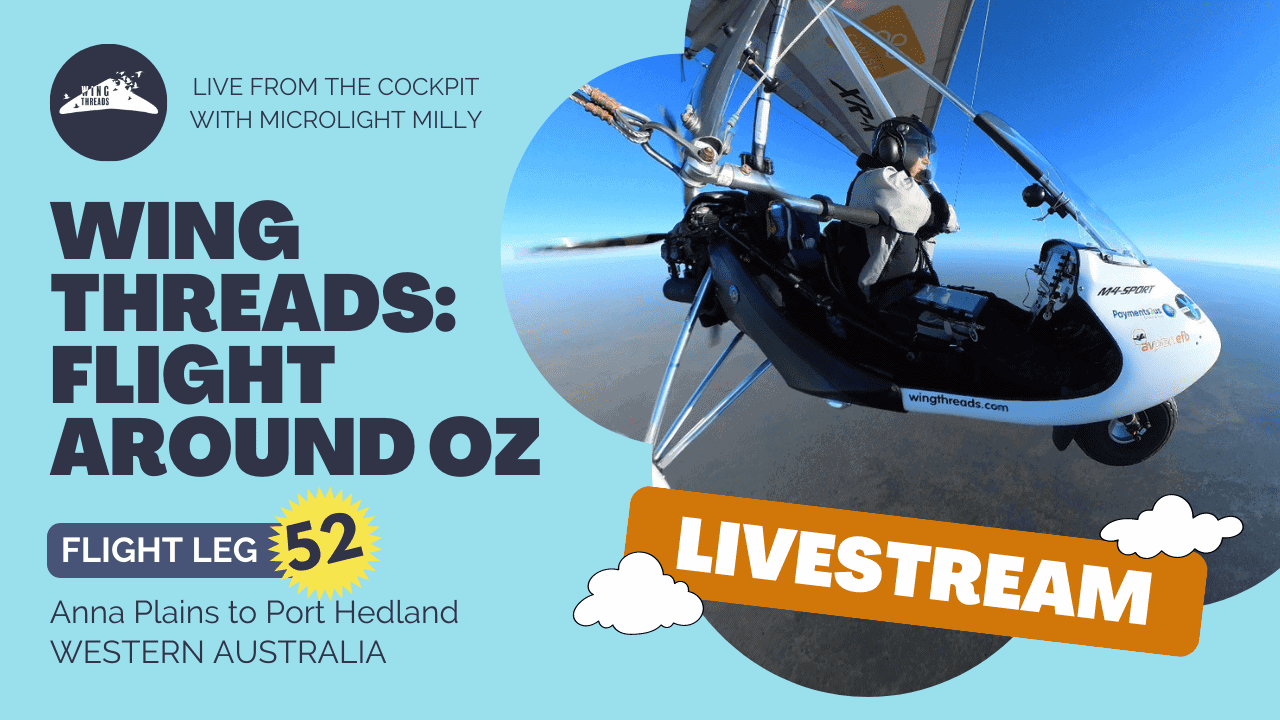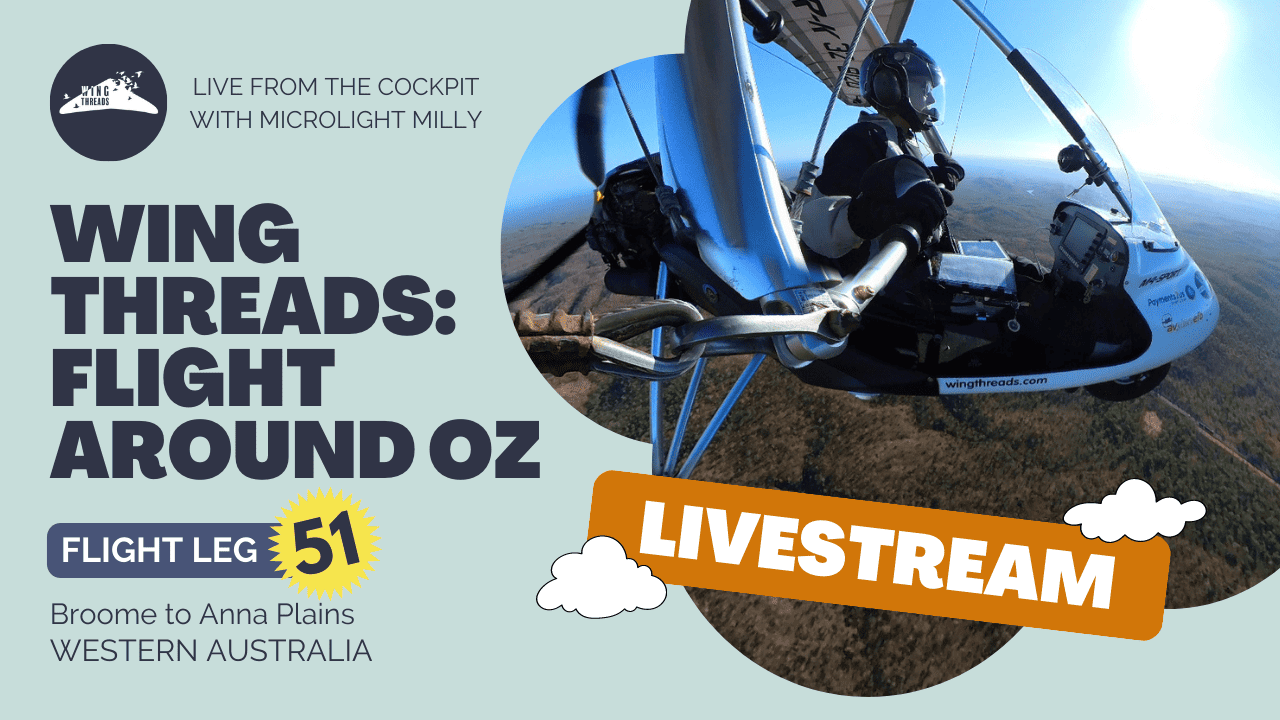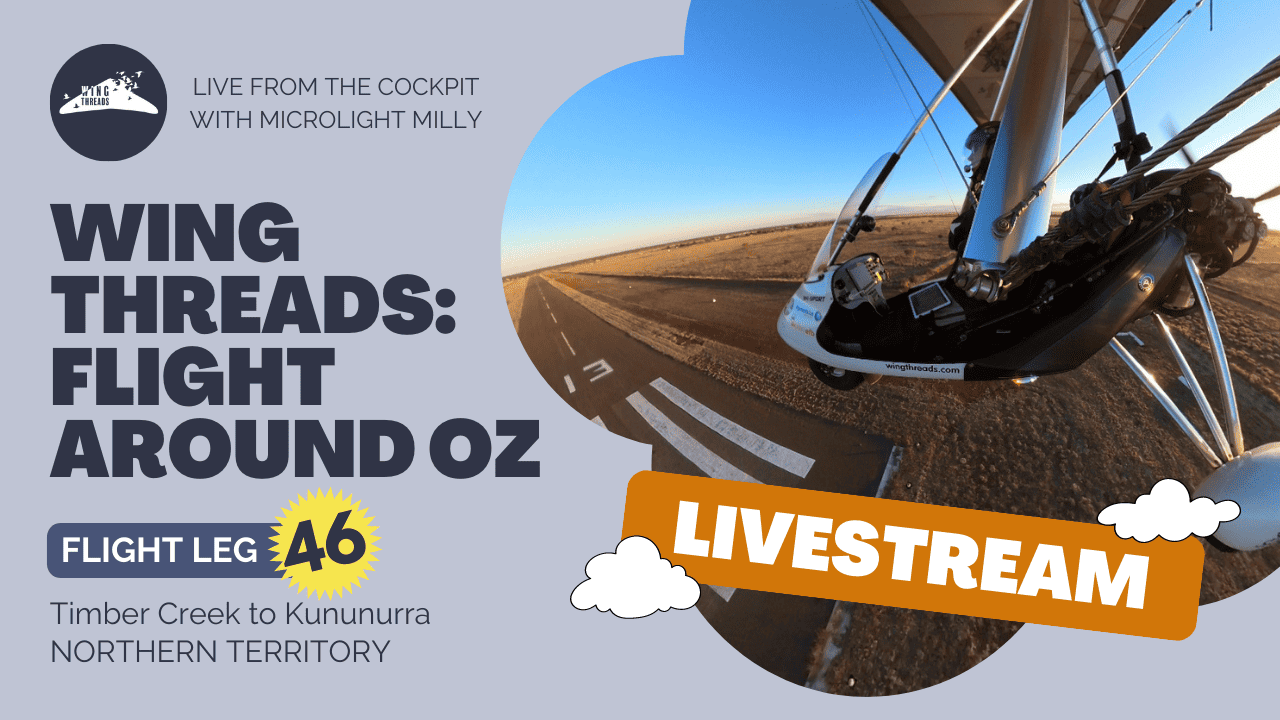History in the making
2019 is the fifth year the North West Australia (NWA) Wader and Tern Expedition team has fitted satellite tags on migratory waders and already we have been amazed by their unexpectedly rapid and long movements.
Prior to 2004, it was thought that the population of Oriental Pratincole in the East Asian Australasian Flyway was around 75,000 birds. In February 2004 during the annual NWA expedition, participants observed an unprecedented, extraordinary number of this species along Eighty Mile Beach and the surrounding plains and as a result, a formal count was organised.
Through ground and aerial based counts, it was estimated that 2.88 million Oriental Pratincoles inhabited the area that year. This was probably due to the plague proportions of grasshoppers occurring at the time and unfavourable weather conditions in other parts of northern Australia.
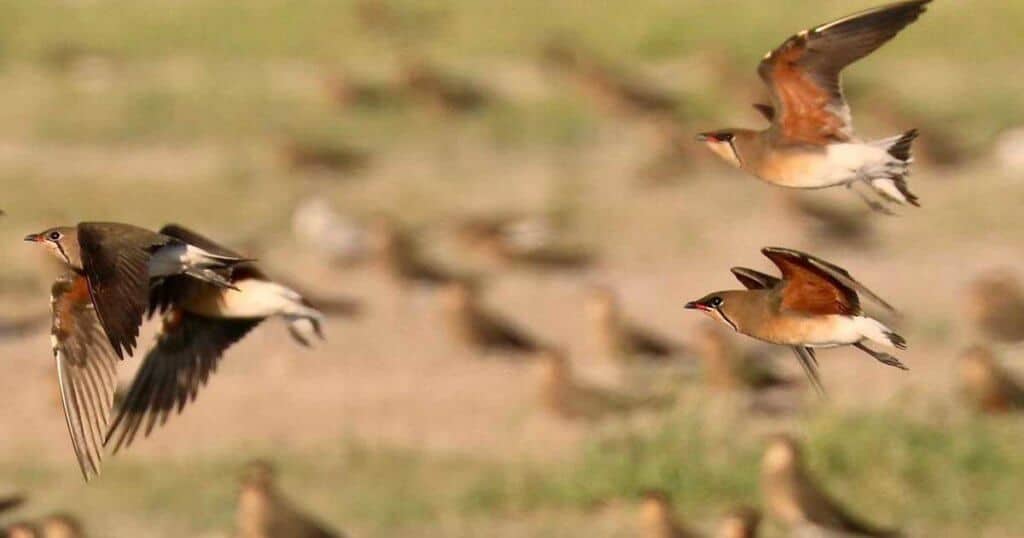
Catching and banding has been regularly undertaken on Eighty Mile Beach and Roebuck Bay since 1981. Oriental Pratincole have been banded in the hope that some insight into their movements both in Australia and during their migrations and breeding may be revealed.
Yet despite over 620 Oriental Pratincoles marked in Australia over the years, there has only been one recorded re-sighting made by Chien-Hua CHEN from the Taiwan Wader Study Group, of a marked bird (plain yellow leg flag) breeding in Taiwan. The ecology and movements of this species are therefore still largely unknown. As a result of this knowledge gap, we have prioritised studying the movements of Oriental Pratincole using Solar 2-gram Platform Terminal Transmitters (PTTs) produced by Microwave Telemetry Inc.
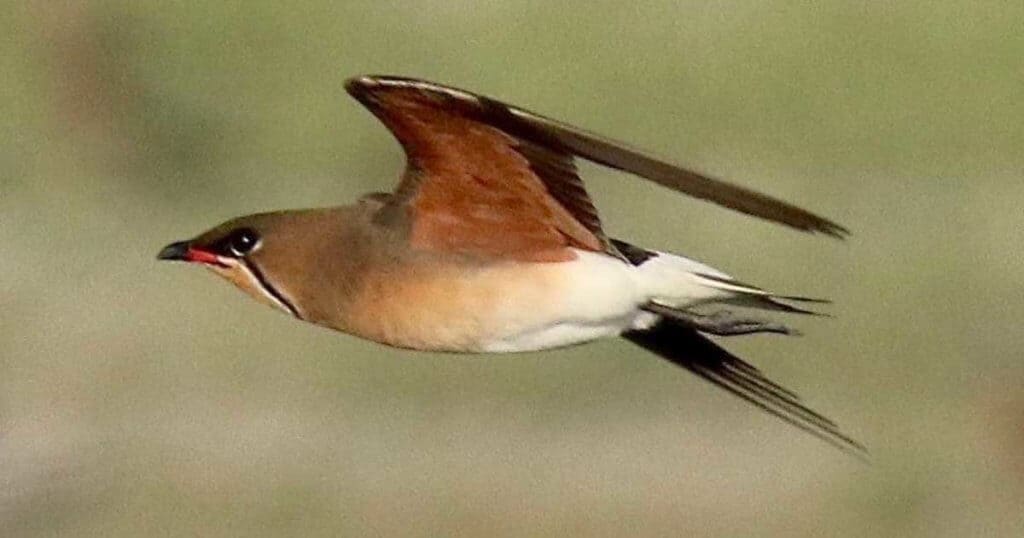
On the 8th February, we caught 14 Oriental Pratincole with a cannon net, on Eighty Mile Beach, 42 kilometres south of Anna Plains Station, (GPS coordinates Lat.-19.482245° Long.121.190040°), and five PTTs were fitted.
The Oriental Pratincoles were banded, with a metal ID band and a yellow engraved leg flag (ELF). We took body measurements and fitted the birds with PTTs using a leg loop harness. The identification details and weights are shown in the table below.
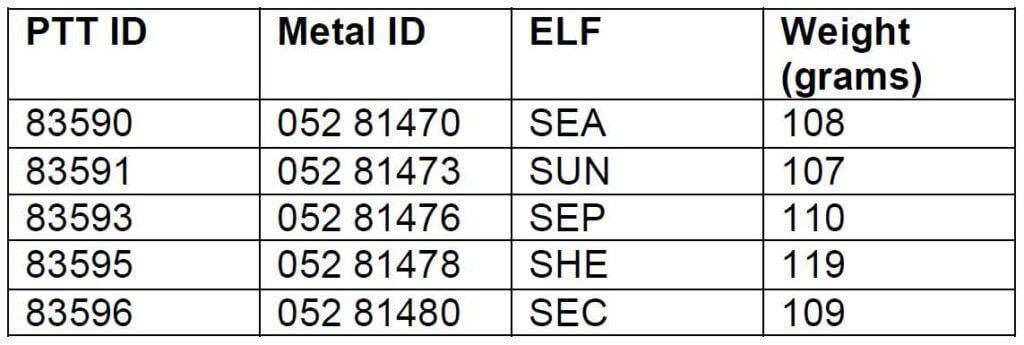
We released all birds at the catch location.
Unexpected and exciting results
Normally when one deploys an electronic tracking device on a bird in the non-breeding area, it remains stationary for a period before it sets off on any migration or major movements. Tracks usually therefore depict the normal daily home range of a bird as it moves between feeding and roosting areas.
However, the five Oriental Pratincoles fitted with similar transmitters on 8th February, 2019, have exhibited markedly different behaviour.
Two birds started to move north eastwards almost immediately after release. Over the next three weeks they visited a range of different locations at distances up to 1200km from the catching location. The other two Oriental Pratincoles have left us in no doubt of their motive – northward migration.
Exploring the outback
Leg Flag SEP – 8th February to 1st March.
11th February – Roebuck Plains
12th February – south of Gibb River Rd, 36km south west of Lennard River Gorge
17th February – 50km south of Fitzroy Crossing
18th February – 30km south of Purnululu National Park (approximately 800km from the release location)
20th February – returning west, 70km south west of Tunnel Creek National park (north of the Great Northern Highway).
23rd February – 25km north of Noonkanbah Airport
28th February – 26km north of Camballin Airport.
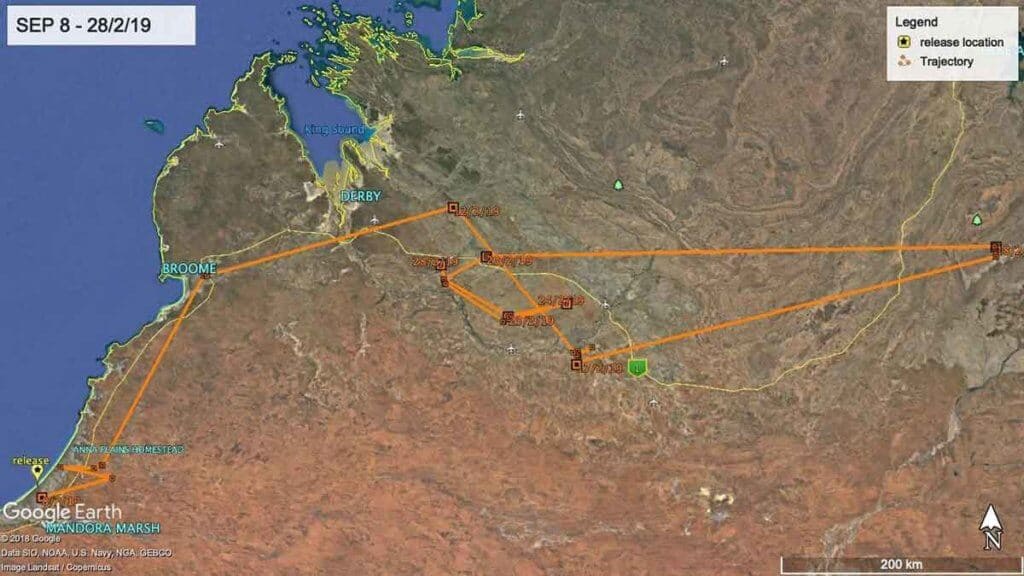
Over the state border
Leg Flag SUN – 8th February to 1st March
At the time of this report, SUN was located 1200km from the release site and has flown approximately 2100km in total.
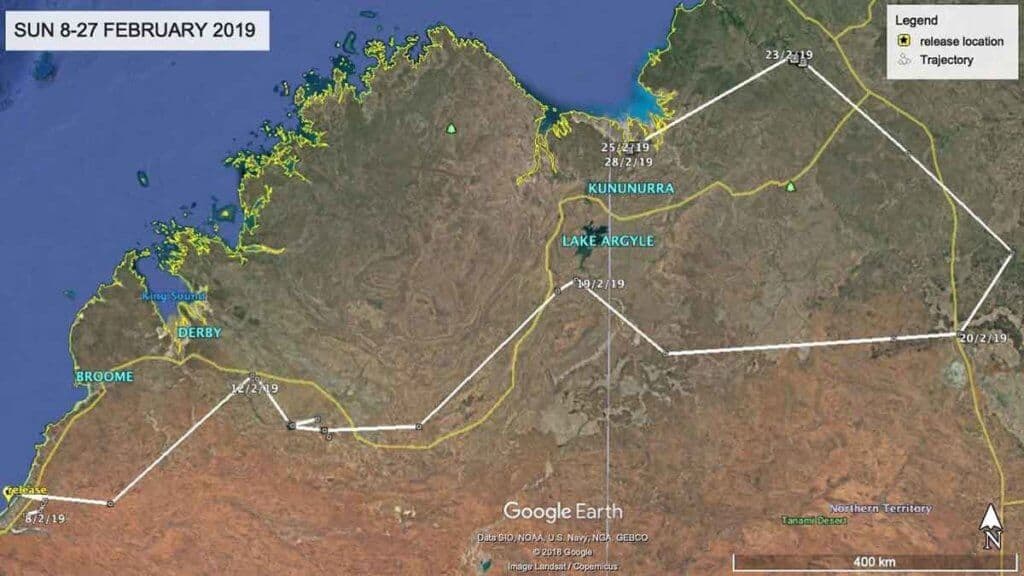
The route taken with approximate distances:
12th February – 37km south west of Camballin Airport. 19/2 40km south of Lake Argyle
20th February – 10km east of Newcastle Waters, Northern Territory (off the Stuart Highway)
23rd February – located 60km south west of Pine Creek, Northern Territory.
28th February – 60km north west Legune Airport.
Our World Traveller
Leg Flag SHE – 8th February to 1st March
After roaming around the southern end of Anna Plains Station for just over a week, SHE abruptly set off northwards out to sea from Eighty Mile Beach, around 16th February and proceeded virtually non-stop (via Indonesia and Borneo) to near Phnom Penh in Cambodia. It covered this 4200km journey in not more than five days which gives an average flight speed of around 45km per hour (including any time making short resting stops). For the last few days it has been situated near the largest lake in Southeast Asia in what looks like ideal Pratincole habitat.
Between 8th and 16th February, this bird remained on at Anna Plains within 25km of the release site. Around the 16th February, SHE surprised everyone by leaving the mainland at Eighty Mile Beach and heading north over the sea.
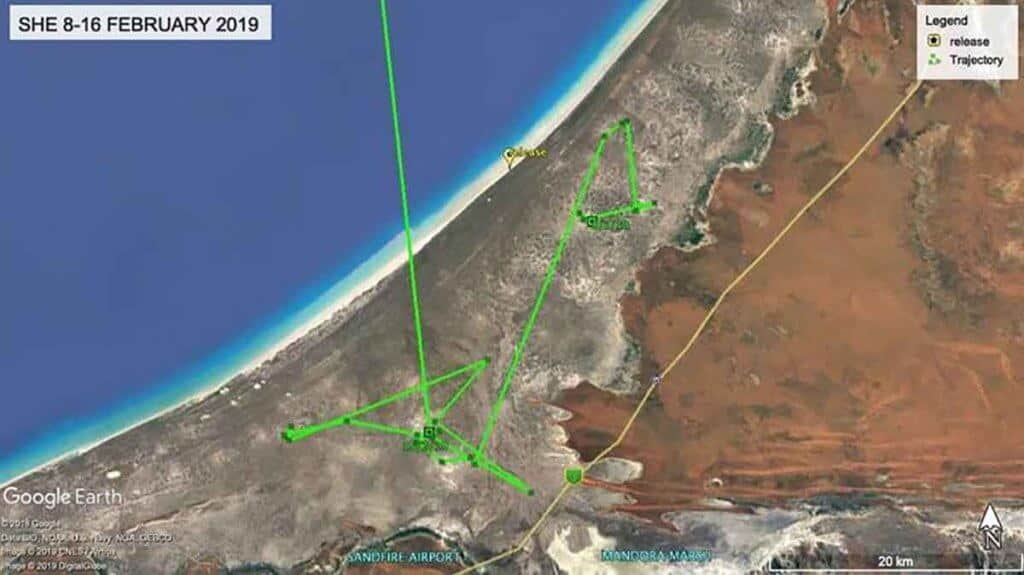
In the early hours of 18th February, we picked up signals from Sulawesi – about 1900km from the release site – 3.5km north of Singkalong Province of South Sulawesi. Later on the same day, SHE was detected 21km south of Laut Island in the Riau Archipeligo, a further 1500km north west of its location earlier the same day.
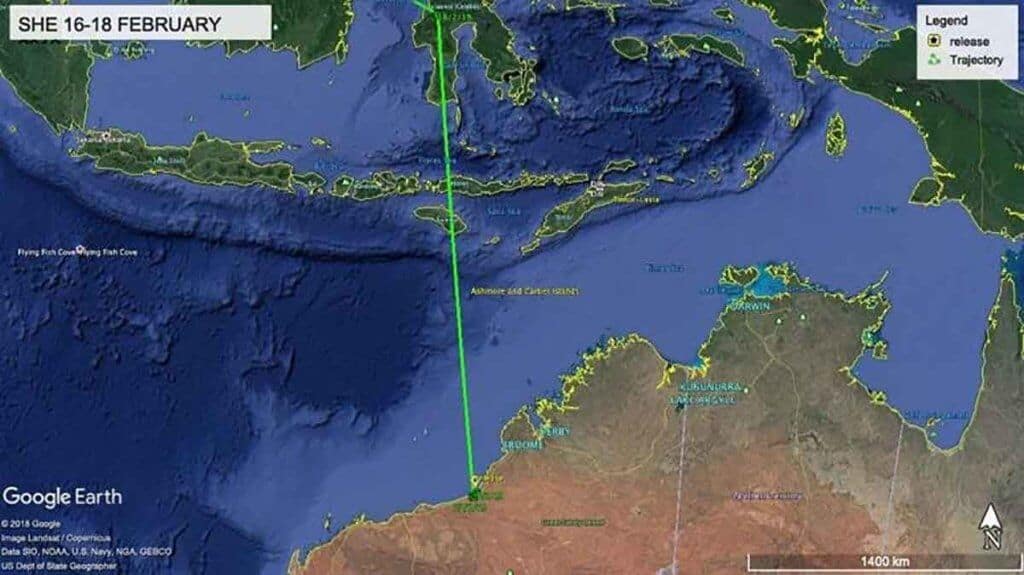
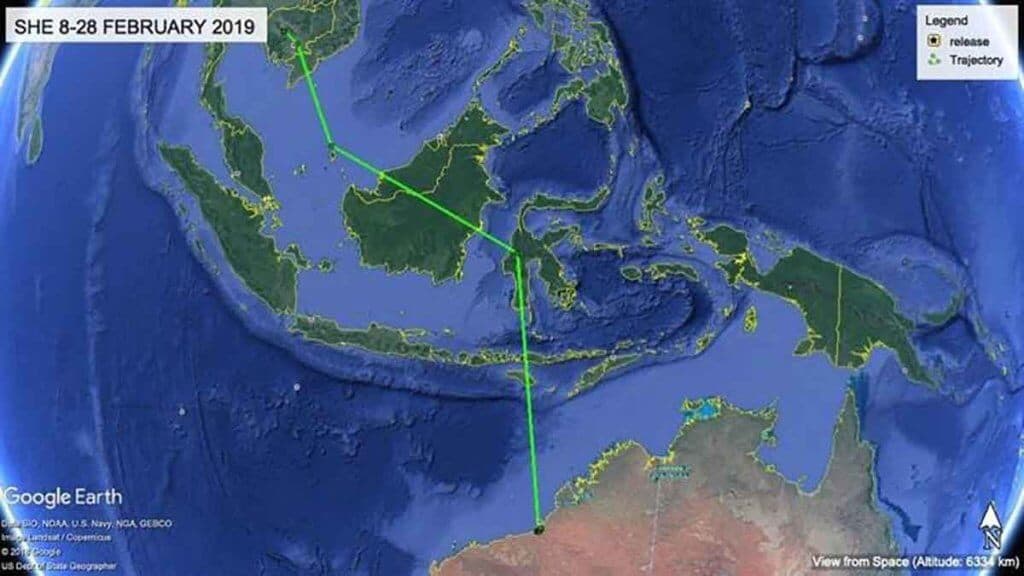
By the 20th February and another 850km further north, SHE was located 36km east of Phnom Penh, Cambodia. On the 22nd February SHE made a short hop to 20km north west of the town of Krakor, in the Pursat Province. SHE was still at this location on the 1 March.
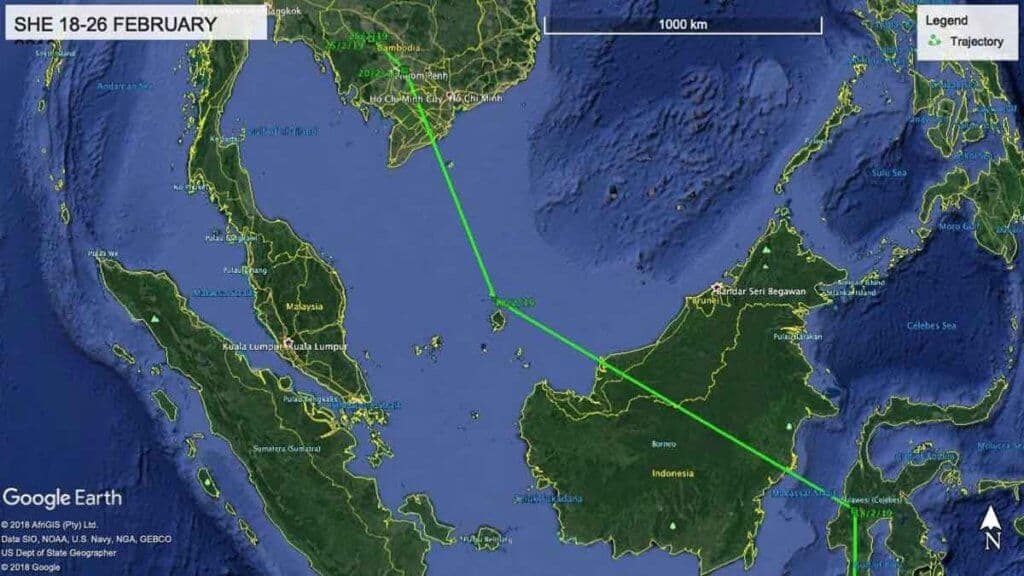
SHE 23 – 27 February
SHE is now enjoying a lakeside view at the largest freshwater lake in Southeast Asia, on the floodplains of the Tonle Sap Lake. This is over 4000km from the release site. It will be interesting to see if she subsequently remains in this area to breed or moves on elsewhere in Southeast Asia. Whether it will remain here to breed or move on elsewhere in due course will be interesting to follow.
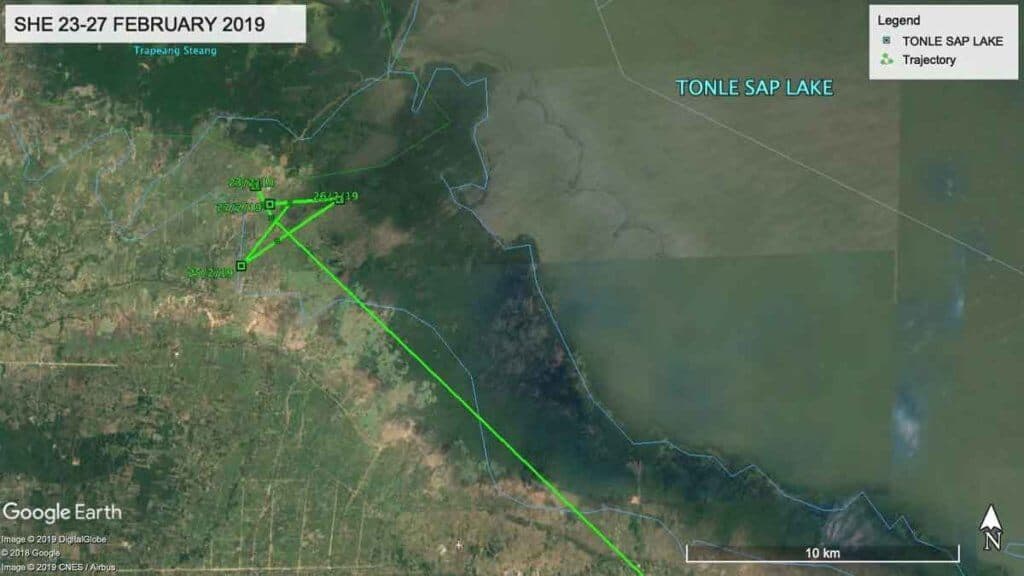
Anna Plains and beyond on the way to Indonesia
Leg Flag SEC – 8th February to 1st March
From the 8th to 23rd February, SEC remained within the boundaries of Anna Plains Station with location data showing it travelled 20km south, then 30km north and on one occasion ventured 40km north east (east of the Great Northern Highway).
In the early hours of 26th February, SEC left Anna Plains, flying via Roebuck Plains on its way north over the Indian Ocean to Indonesia.
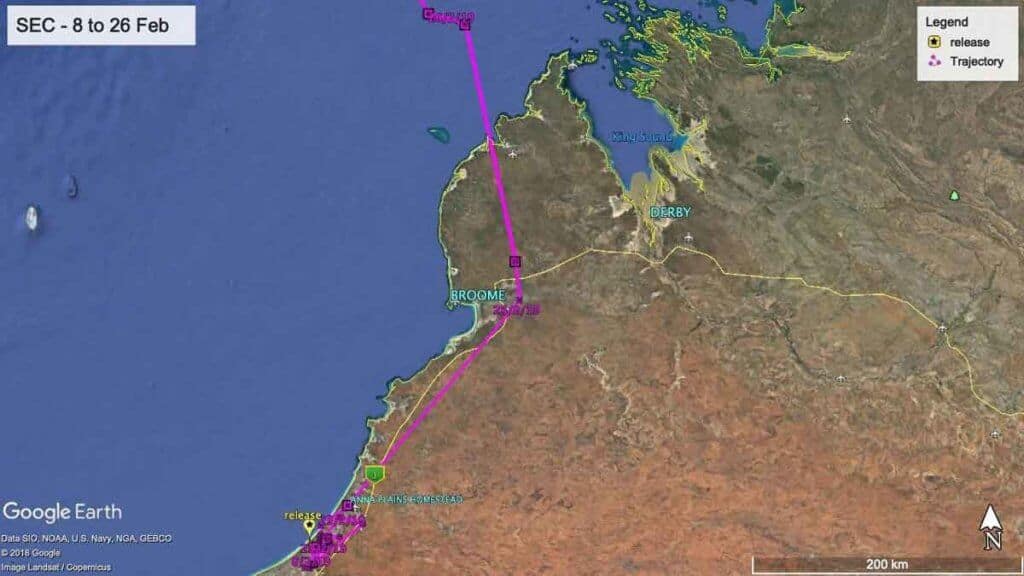
27th February – 1st March
From the signals received, SEC has made its way north west over Bali, and has landed in south west Indonesia, 5km north of Air Hitam Village. More recent signals, but of low accuracy, suggest it may have resumed its northward movement towards Borneo.
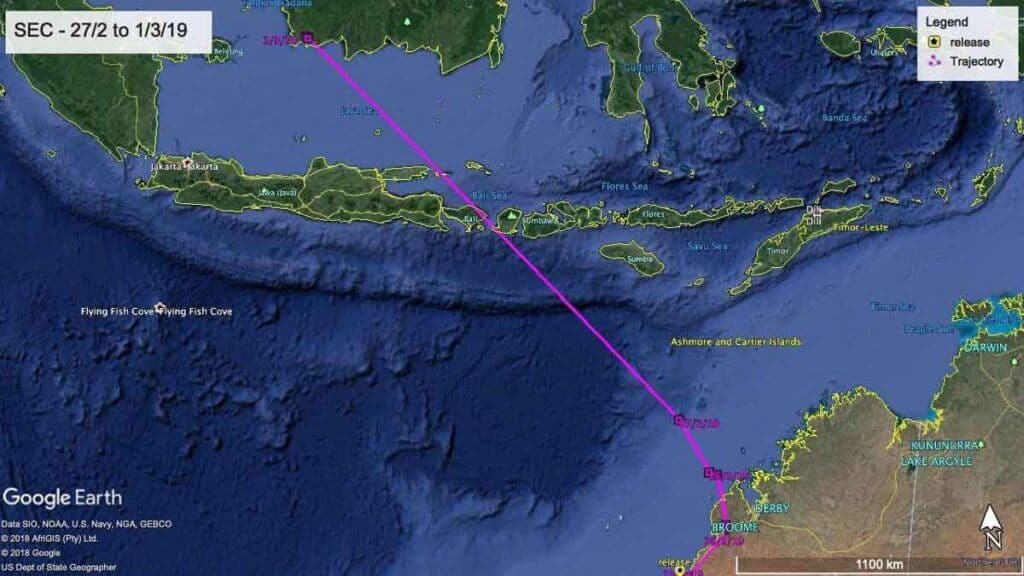
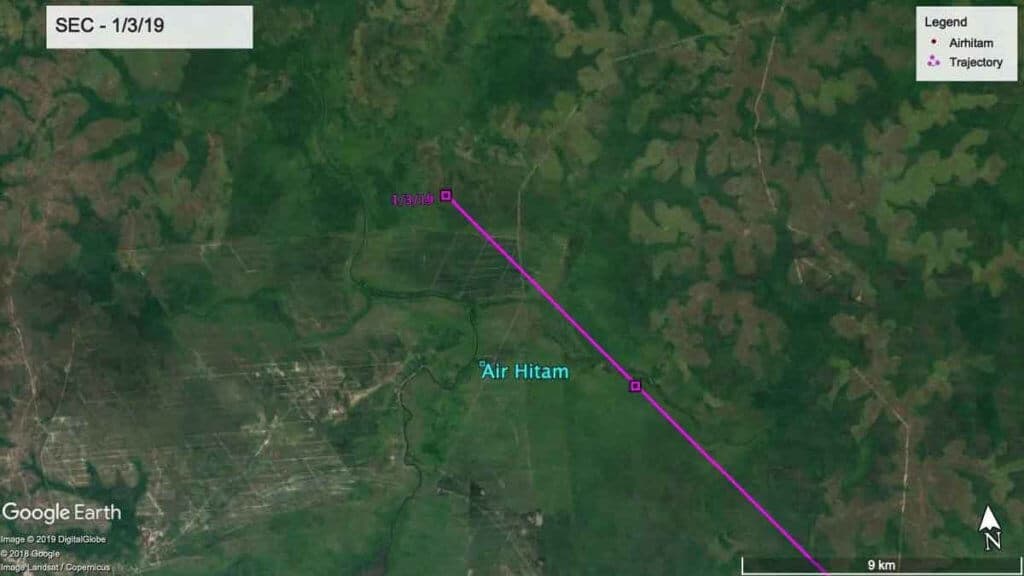
Going Nowhere
Leg Flag SEA – 8th February
Unfortunately, the transmitter on this bird ceased to transmit after the release on 8th February.
More to come!
We have been incredibly fortunate in deploying satellite transmitters on Oriental Pratincoles just at the time some were setting off on their northward migration. The majority arrive in Australia in December and were already known to leave in February – the shortest time observed for any migratory wader species. Maybe further data will give us some idea of why such an early departure is favoured by this species.
It will be interesting also to see whether the two Oriental Pratincoles remaining in Australia move into ‘long distance migration mode’ in the future, or whether they continue northwards in more gradual steps as they have done up to the present within Australia.
We hope everybody enjoys this fantastic news which has emerged so early in this year’s NWA satellite tagging project. Let us hope there are many more exciting revelations to come on Oriental Pratincoles and on the other species over the next few months!
Acknowledgements
Clive Minton
The extensive and expensive satellite tracking program we have set up in NWA has only been possible through the efforts and generosity of a large number of people and organizations. It is difficult to know where to start with the formal acknowledgements so I will list them – but not in any particular order of priority.
- The members of the AWSG NWA 2019 Wader and Tern Expedition and similar NWA expeditions in previous years, are particularly thanked for their efforts in the field in catching, banding and deploying transmitters on a range of species.
- Landowners are especially thanked for permission to go onto their property to enable us to catch various species in order to deploy the satellite transmitters. In particular we thank Anna Plains Station for giving us the freedom to roam over large areas of grazed grassland when counting and catching target species.
- AWSG acknowledges the Yawuru People via the offices of Nyamba Buru Yawuru Limited for permission to catch birds on the shores of Roebuck Bay, traditional lands of the Yawuru people.
- AWSG acknowledges the Karajarri and Nyangumarta people for permission to catch birds to be marked for this project on the shores of 80 Mile Beach, traditional lands of the Karajarri and Nyangumarta.
- The cost of the satellite transmitters, which cost around $5000 each, and the satellite downloading costs (around $1000-1500 per month) have been met by a variety of sources. Private individuals (Charles Allen and Doris Graham) have made most generous individual contributions. Kate Gorringe-Smith and her team of artists involved in The Overwintering Project made a large, generous donation from funds raised during their various public exhibitions. The annual NWA Expedition members, collectively, also provided significant funds each year.



